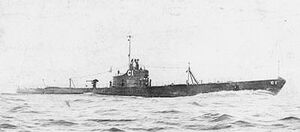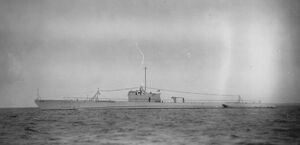Cachalot and Cuttlefish: Difference between revisions
Pbcjohnston (talk | contribs) Added cuttlefish photo |
Pbcjohnston (talk | contribs) Added design and construction notes section |
||
| Line 1: | Line 1: | ||
[[File:Header 171.jpg]] | [[File:Header 171.jpg]] | ||
=== <big>Design and Construction Notes</big> === | |||
<div style="text-align: justify;"><span style="color:#00008B">It was originally intended to build two additional copies of the preceding Dolphin design for the final two V-boats. But, bowing to pressure from international treaties that limited total submarine displacement, and by strong advocacy from small-submarine elements within the Submarine Officer's Conference and the General Board, the two Fiscal Year 1932 boats were built to a smaller size and displacement. Cachalot's construction was assigned to Portsmouth, and Cuttlefish was contracted to Electric Boat, breaking a seven-year gap in construction for EB. | |||
In the original construction authorization for the V-class dating back to 1916, these two boats were known as V-8 and V-9. However, by the time the construction contracts were signed, their names were changed. Thus, these boats never officially carried those names. | |||
EB was eager to get back into the submarine construction business, so they asked for and received permission to make several changes to the basic design as developed by the USN Bureau of Construction & Repair. They were able to provide separate crew's berthing and messing, and they expanded the use of welding in the hull fabrication, although both Cachalot and Cuttlefish were built to a [https://pigboats.icci.llc/images/3/37/NO_MORE_HEADS_OR_TAILS_TSR_version.pdf '''partial riveted/partial welded construction method''']. Cuttlefish was also the first boat in the fleet to receive an air-conditioning plant, with its use so successful that all of the fleet submarines were subsequently refitted with one, and all future boats built with a plant as original equipment. The Torpedo Data Computer (TDC), a mechanical computer used to provide a firing solution for torpedoes, was first tested in these boats, proving the concept. | |||
While generally successful, these boats were ultimately too small and had too short a range for the role of operating with the fleet in the vast Pacific. After several non-productive war patrols in the early months of WWII, they were retired back to the States and served well as training boats for the remainder of the war.</span> | |||
[[File:Red bar sub new 2.jpg]] | |||
=== <big>Cachalot (SS-170)</big> === | === <big>Cachalot (SS-170)</big> === | ||
Revision as of 14:13, 22 June 2023
Design and Construction Notes
In the original construction authorization for the V-class dating back to 1916, these two boats were known as V-8 and V-9. However, by the time the construction contracts were signed, their names were changed. Thus, these boats never officially carried those names.
EB was eager to get back into the submarine construction business, so they asked for and received permission to make several changes to the basic design as developed by the USN Bureau of Construction & Repair. They were able to provide separate crew's berthing and messing, and they expanded the use of welding in the hull fabrication, although both Cachalot and Cuttlefish were built to a partial riveted/partial welded construction method. Cuttlefish was also the first boat in the fleet to receive an air-conditioning plant, with its use so successful that all of the fleet submarines were subsequently refitted with one, and all future boats built with a plant as original equipment. The Torpedo Data Computer (TDC), a mechanical computer used to provide a firing solution for torpedoes, was first tested in these boats, proving the concept.
While generally successful, these boats were ultimately too small and had too short a range for the role of operating with the fleet in the vast Pacific. After several non-productive war patrols in the early months of WWII, they were retired back to the States and served well as training boats for the remainder of the war.
Cachalot (SS-170)


